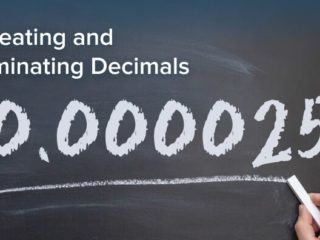Last Updated on May 4, 2023
GMAT OFFICIAL GUIDE PS
Solution:
When reading through this question, notice that we are asked which of the following is a POSSIBLE value of E – S. This tells us that we will not be looking for a definite answer here.
We are given that list T has 30 decimals, and that the sum of this list is S.
Next we are given that each decimal whose tenths digit is even is rounded up to the nearest integer and each decimal whose tenths digit is odd is rounded down to the nearest integer.
We are next given that E is the sum of these resulting integers.
Finally, we are given that 1/3 of the decimals in list T have a tenths digit that is even. This this means that 2/3 have a tenths digit that is odd. This means we have 10 decimals with an even tenths digit and 20 decimals with an odd tenths digit.
This is very helpful because we are going to use all this information to create a RANGE of values. We will calculate both the maximum value of E – S and the minimum value of E – S.
Another way to say this is that we want the maximum value of the sum of our estimated value in list T minus the sum of the actual values in list T and also the minimum value of the sum of the estimate values in list T minus the sum of the actual values in list T. Thus, we need to determine the largest estimated values and the smallest estimated values for the decimals in list T.
To do this, let’s go back to some given information:
Each decimal whose tenths digit is even is rounded up to the nearest integer.
Each decimal whose tenths digit is odd is rounded down to the nearest integer.
Let’s first compute the maximum estimated values for the decimals in list T. To get this, we want our 10 decimals with an even tenths digit to be rounded UP as MUCH as possible and we want our 20 decimals with an odds tenths digit to be rounded DOWN as LITTLE as possible. Thus, we can use decimals of 1.2 (for the even tenths place) and 1.1 (for the odd tenths place). Let’s first calculate S, or the sum of the 30 decimals. We know we have 10 decimals of 1.2 and 20 decimals of 1.1, so we can say:
S = 10(1.2) + 20(1.1) = 12 + 22 = 34
Now we can round up 1.2 to the nearest integer and round down 1.1. We see that 1.2 rounded up to the nearest integer is 2, and 1.1 rounded down to the nearest integer is 1. So now we can calculate E, or the sum of the resulting integers. We can say:
E = 10(2) + 20(1) = 20 + 20 = 40
Thus, the maximum value of E – S, in this case, is 40 – 34 = 6.
Let’s next compute the minimum estimated values for the decimals in list T. To get this we want our 10 decimals with an even tenths digit to be rounded UP as LITTLE as possible and we want out 20 decimals with an odds tenths digit to be rounded DOWN as MUCH as possible. Thus, we can use decimals of 1.8 (for the even tenths place) and 1.9 (for the odd tenths place). Let’s first calculate S, or the sum of the 30 decimals. We know we have 10 decimals of 1.2 and 20 decimals of 1.1, so we can say:
S = 10(1.8) + 20(1.9) = 18 + 38 = 56
Now we can round up 1.8 to the nearest integer and round down 1.9 to the nearest integer. 1.8 rounded up to the nearest integer is 2, and 1.9 rounded down to the nearest integer is 1. So now we can calculate E, or the sum of the resulting integers, so we can say:
E = 10(2) + 20(1) = 20 + 20 = 40
Thus, the minimum value of E – S, in this case, is 40 – 56 = -16.
Thus, the possible range of E – S is between -16 and 6, inclusive. We see that I and II fall within this range.
Note that you can use any combination of decimals here as long as they fit the criteria of positive and non-integer.
Answer: B



